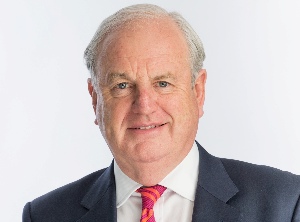
David McLean
by BusinessDesk

David McLean
The parent bank is also seeking to raise A$2.5 billion in fresh equity to provide a larger buffer of capital above the regulatory minimum.
But the New Zealand subsidiary also delivered good news on the capital front with the Reserve Bank of New Zealand releasing it from a two-year period in purgatory for failing to get nearly half its internal models for calculating capital approved, a failure dating back to 2008 when it was first accredited to use the models.
RBNZ had ordered Westpac New Zealand to hold about $1 billion of additional capital for those two years, a two-percentage-point overlay above its minimum required capital. RBNZ has now removed that impost.
Westpac New Zealand's net profit for the year ended September rose to $964 million from $936 million, boosted by a $10 million write-back of charges against profit for bad debts and the $40 million gain from selling its Paymark stake.
The parent bank's net profit fell to A$6.78 billion for the year from A$8.1 billion the previous year.
The New Zealand subsidiary says its core earnings were down 1 percent and cites strong competition and increased investment in technology, risk and compliance systems – operating costs rose 7 percent to $993 million while net interest income was nearly flat at $1.97 billion and non-interest income rose 10 percent to $448 million.
But the investment in risk and compliance earned it praise from RBNZ with deputy governor Geoff Bascand saying Westpac is now "operating with peer-leading processes, capabilities and risk models.
"Westpac has taken the findings of the independent review as an opportunity to make meaningful improvements to its risk management and we commend it for its cooperative and constructive engagement," Bascand says in his statement lifting the capital penalty.
RBNZ is now satisfied Westpac meets the appropriate standards.
"Looking forward, we will continue to hold all internal model banks to the same high standards," Bascand says – ANZ Bank has also run afoul of the requirements to get its internal models approved.
The only banks in NZ allowed to use internal models are the four Australian-owned banks that account for about 88 percent of NZ's banking system.
Westpac doesn't say what its capital ratios were at Sept. 30 but its parent's common equity tier 1 ratio at that date was 10.67 percent, just above the Australian Prudential Regulatory Authority's 10.5 percent minimum "unquestionably strong" benchmark. The capital raising will lift that ratio to 11.25 percent.
The New Zealand subsidiary's chief executive David McLean says low interest rates are providing opportunities for first-home buyers and others wanting to buy property.
"We've never seen interest rates this low in New Zealand. It helps with housing affordability and business investment and presents a great opportunity for existing borrowers to pay down debt," McLean says in a statement.
Two-thirds of Westpac NZ's customers are ahead of their mortgage payments by a median average of eight months or an average $8,652 at Sept. 30, he says.
What McLean doesn't say is that falling interest rates tend to make it harder for banks to make profits and Westpac NZ's average net interest margin fell 8 basis points to 2.16 percent compared to the previous year.
The Australian parent's slides show a continued deterioration with New Zealand net interest margin averaging 2.34 percent in the first half and sinking to 2.09 percent in the second half.
RBNZ has cut its official cash rate from 1.75 percent to 1 percent so far this year, helping to explain the pressure on margins.
Westpac NZ says its mortgage and business lending grew 5 percent in the year while customer deposits grew 4 percent, accounting for 76.6 percent of lending in the second half compared with 78.2 percent in the first half and 77 percent in the previous second half.
"Our commercial, corporate and institutional banking team have continued to build upon the good relationships they have in industry," McLean says.
"Our agri book is also in solid shape. Continued favourable conditions on farms have seen agri lending increase by 4 percent and deposits by 3 percent year-on-year," he says.
The parent's slides show the NZ agribusiness portfolio grew from $9.2-9.5 billion in the year, accounting for 8.1 percent of total capital employed and that 10 percent is classed as "stressed," up from 9.7 percent a year earlier, but that only 0.32 percent is impaired, down from 0.42 percent.
The parent says overall agribusiness portfolio health remains sound with dairy stressed assets largely flat and the "focus remains on supporting existing dairy customers with proven long-term viability."
Mortgages accounted for 61 percent of the NZ lending portfolio and 92 percent of that was below 80 percent loan-to-valuation ratios. Only 0.13 percent of the mortgage portfolio was classed as 90 days or more past due.
Much of the reason for the parent bank's profit decline reflected the outcome of Australia's royal commission into financial services with the bank spending about A$350 million since 2017 on refunding more than 500,000 customers.
McLean says the NZ bank "continued to work constructively" with RBNZ and the Financial Markets Authority on their joint review of conduct and culture sparked by the Australian commission.
Westpac NZ has reduced or removed 13 fees in the past year and removed five products from service or sale. "It was also proactively identifying and remedying historical issues with some products and services," McLean says.
| « Westpac makes $964 million profit | Vincent Capital adds a South Island BDM » |
Special Offers
No comments yet
Sign In to add your comment

© Copyright 1997-2025 Tarawera Publishing Ltd. All Rights Reserved